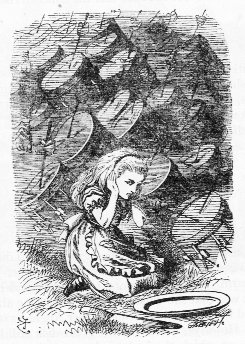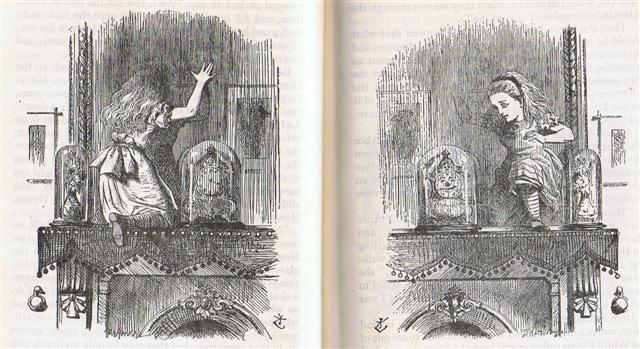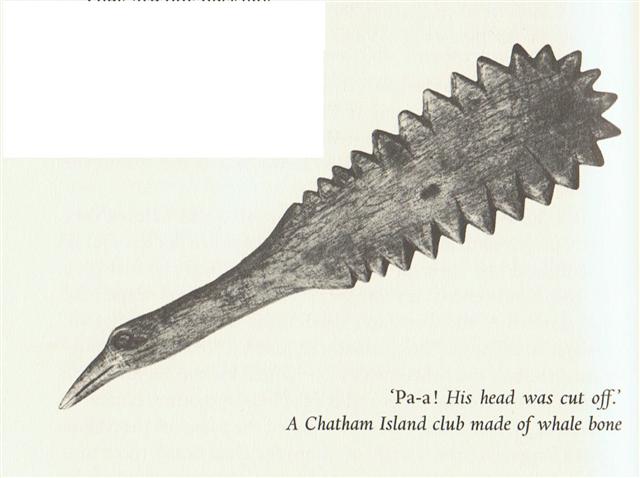|
584
39 Once again. As we should remember Raven had also a hole he could use down at the surface of the sea: ... He turned round and round to the right as he fell from the sky back to the water. Still in his cradle, he floated on the sea. Then he bumped against something solid. 'Your illustrious grandfather asks you in', said a voice. The Raven saw nothing. He heard the same voice again, and then again, but still he saw nothing but water. Then he peered through the hole in his marten-skin blanket. Beside him was a grebe. 'Your illustrious grandfather asks you in', said the grebe and dived. Level with the waves beside him, the Raven discovered the top of a housepole made of stone. He untied himself from his cradle and climbed down the pole to the lowermost figure ... The surface of the sea was like a spirit level in demonstrating the direction across from the horizon (Leech) in the east to the other one at the descent in the west,
i.e. it was the Path of the Sun, the Road of the Spider.
... Take the lower part of a gourd or hula drum, rounded as a wheel (globe), on which several lines are to be marked and burned in, as described hereafter. These lines are called na alanui o na hoku hookele, the highways of the navigation stars, which stars are also called na hoku ai-aina, the stars which rule the land. Stars lying outside these three lines are called na hoku a ka lewa, foreign, strange, or outside stars. The first line is drawn from Hoku-paa, the fixed or North Star, to the most southerly star of Newe, the Southern Cross. (This hour circle coincides with the meridian on an evening in June, when it would divide the visible sky into halves.) The portion (of the sky) to the right or east of this line (the observer is evidently assumed to be facing north) is called ke ala ula a Kane, the dawning or bright road of Kane, and that to the left or west is called ke alanui maawe ula a Kanaloa, the much-traveled highway of Kanaloa. (Kane and Kanaloa were important gods in the Polynesian pantheon, Kane being associated with light, Kanaloa with darkness.) Then three lines are drawn east and west, one across the northern section indicates the northern limit of the Sun (corresponding with the Tropic of Cancer) about the 15th and 16th days of the month Kaulua (i.e., the 21st or 22nd of June) and is called ke alanui polohiwa a Kane, the black-shining road of Kane. The line across the southern section indicates the southern limit of the Sun about the 15th or 16th days of the month Hilinama (December 22) and is called ke alanui polohiwa a Kanaloa, the black-shining road of Kanaloa. The line exactly around the middle of the sphere is called ke alanui a ke ku'uku'u, the road of the spider ... These two holes - the fresh one created by his beak and the already existing one in the skin blanket - could, I suspect, together illustrate declination 45º. Because (0 + 90) / 2 = 45 and because here I can recall a similar pair of holes: ... In the program was discussed if Irish people could have visited North America around 500 AD. Otherwise it would be hard to account for the little sun observatory constructed by stone slabs found in Connecticut. The architecture was identical with what could be expected from Irish visitors around that time. No other known culture had something similar. In a way the observatory in Connecticut resembled - I thought - the very old Mnajdra solar observatory. Here the rays from the Sun were used to display a pair of crucial times in the year. But in fundamental contrast to the Mnajdra temple the Connecticut structure was catching the rays from the sun at winter solstice and the sun at spring equinox (instead of summer solstice) ...
The plate in front of Alice, trying to keep the sound of drums at bay by shielding her audial orifices with her hands, ... The most important of all drums, he said, was the armpit drum. The Nummo made it. It consists of two hemispherical wooden cups connected through their centres by a slender cylinder. It is like an hour-glass with a very long narrow neck. With this instrument tucked between his left arm and armpit, the drummer, by pressing on the hollow structure of thin wood, can tighten or relax the tension on the skins and so modify the tone. 'The Nummo made it. He made a picture of it with his fingers, as children do today in games with string.' Holding his hands apart, he passed a thread ten times round each of the four fingers, but not the thumb. He thus had forty loops on each hand, making eighty threads in all, which, he pointed out, was also the number of teeth of his jaws. The palms of his hands represented the skins of the drum, and thus to play on the drum was, symbolically, to play on the hands of the Nummo. But what do they represent? Cupping his two hands behind his ears, Ogotemmêli explained that the spirit had no external ears but only auditory holes. 'His hands serve for ears,' he said; 'to enable him to hear he always holds them on each side of his head. To tap the drum is to tap the Nummo's palms, to tap, that is, his ears.' Holding before him the web of threads which represented a weft, the Spirit with his tongue interlaced them with a kind of endless chain made of a thin strip of copper. He coiled this in a spiral of eighty turns, and throughout the process he spoke as he had done when teaching the art of weaving. But what he said was new. It was the third Word, which he was revealing to men ... could represent the circular flat surface needed in order to properly pinpoint the local time-space.
And without a straight vertical (90º) 'beacon' the necessary shadowy figure (the tanist) could not be obtained. A di-al means a pair. ... Freeman describres the dualistic cosmology of the Pythagorean school (-5th century), embodied in a table of ten pairs of opposites. On one side there was the limited, the odd, the one, the right, the male, the good, motion, light, square and straight. On the other side there was the unlimited, the even, the many, the left, the female, the bad, rest, darkness, oblong and curved ... ... This Hercules is male leader of all orgiastic rites and has twelve archer companions, including his spear-armed twin, who is his tanist or deputy. He performs an annual green-wood marriage with a queen of the woods, a sort of Maid Marian. He is a mighty hunter and makes rain, when it is needed, by rattling an oak-club thunderously in a hollow oak and stirring a pool with an oak branch - alternatively, by rattling pebbles inside a sacred colocinth-gourd or, later, by rolling black meteoric stones inside a wooden chest - and so attracting thunderstorms by sympathetic magic ...
Consequently the Head should be at the top and a straight dia-meter across from one Clew to the other could then be found below. (Disregarding the curvature of the surface of the earth.) For the Foot (→ Rigel. *78) should be straight below the Head in the center (at origo) between this pair of clew Fists. ... The practice of turning down the fingers, contrary to our practice, deserves notice, as perhaps explaining why sometimes savages are reported to be unable to count above four. The European holds up one finger, which he counts, the native counts those that are down and says 'four'. Two fingers held up, the native counting those that are down, calls 'three'; and so on until the white man, holding up five fingers, gives the native none turned down to count. The native is nunplussed, and the enquirer reports that savages can not count above four ...
As I remember it all body parts of Captain Cook were returned after his assassination - with the exception of his head and pair of hands. Pare. Half raw, badly cooked. Parehaoga, food prepared in the earth oven (umu parehaoga) for a feast or for people whose help is needed for some work or for organizing a feast. Parehe, piece, bit; to fall, break into pieces. Parei, dirty, to have a dirty face and eyes, someone who gets up without washing. Parera, sea bottom. Vanaga. Ta.: Pare, a fort, a place of refuge. Ma.: parepare, a breastwork in a stockade. Mgv.: Pare, a covering for the head. Mq.: pae, id. Sa.: pale, id. Ma.: pare, id. Churchill. Parehe, to break, a crack. Parei, 1. (paré), dressed up. 2. To sparkle (of the eyes). Parera, 1. A shallow, a reef. 2. Deep water, profound, gulf; parera tai, deep sea; tai parera, high tide; hohonu parera, fathomless, unsoundable. 3. To lead astray. Hakaparera, to frighten, to scare. Pareu, skirt, apron. Mgv., Mq., Ta.: pareu, loincloth, apron. Pau.: Parego, to drown oneself. Ta.: paremo, drowned. Ma.: paremo, id. Pa. 1. Mgv.: pa, an inclosure, a fenced place. Ta.: pa, inclosure, fortification. Mq.: pa, inclosure. Sa.: pa, a wall. Ma.: pa, a fort. 2. Mgv.: pa, to touch. Sa.: pa'i, id. Ma.: pa, id. 3. Mgv.: pa, to prattle. Ta.: hakapapa, to recount. 4. Mq.: pa, a hook in bonito fishing. Sa.: pa, a pearlshell fishhook. Ma.: pa, a fishhook. Pau.: hakapa, to feel, to touch. Mgv.: akapa, to feel, to touch, to handle cautiously.
|
||||||||||||||||||||||||||||||||||||||||||||||||||||||||||||||||||||||||||||||||||||||||||||||||||||||||||||||||||||||||








.jpg)










